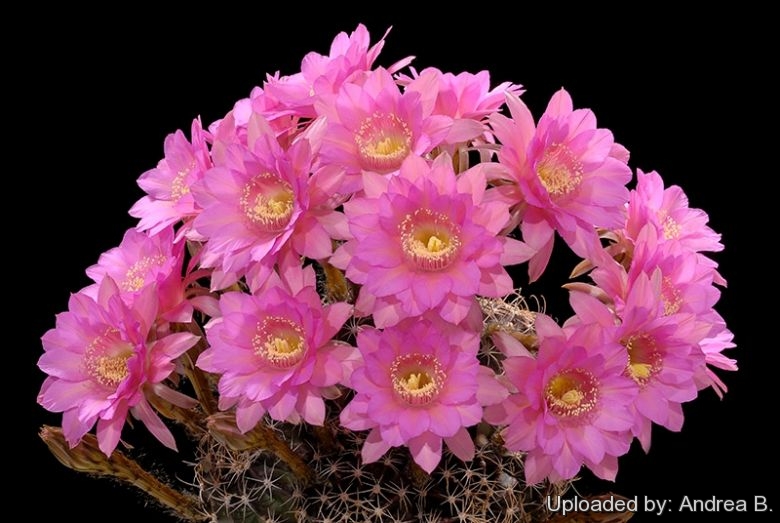




Your support is critical to our success.

Origin and Habitat: Tapacari province, Cochabamba, Bolivia (Western South America, Southern America).
Altitude: Around 2500 metres above sea level.
Synonyms:
- Echinopsis callichroma Cárdenas
- Pseudolobivia callichroma (Cárdenas) Backeb.
Description: Echinopsis callichromaSN|21037]]SN|12009]] is a nice cactus specieswith bright red-magenta to fuschia flowers, and long funnel-formed.
Habit: It is almost always solitary, although it may occasionally branch from the base, possibly as the result of injury.
Related species: Someone suggests it could be one the very variable population of plants around Echinopsis obrepandaSN|12009]]SN|21037]] or other similar species.
Stem: Globose, depressed globose to somewhat conical, greyish green 2-3 cm tall, 12-15 cm across, often nearly buried with only the summit visible above ground.
Ribs: 17 to 19 deeply crenate, rather high, (up to 1 cm high) broken into long acute, hatchet-shaped, tubercles, separated by acute intervals that may form a spiral pattern around the plant.
Areoles: Felted, elliptical, grey, about 1-2,5 cm cm apart.
Radial spines: 12-14, pectinate, flexible, curved, grey, needlelike, 2-6 cm long.
Central spines: Usually absent.
Flowers: Diurnal, slender funnelform 8-9 cm long, tepals fuchsia-pink to bright reddish magenta with darker midveins.
Blooming season: Blooms are produced in spring and remain open for about two days.
Bibliography: Major references and further lectures
1) James Cullen, Sabina G. Knees, H. Suzanne Cubey “The European Garden Flora Flowering Plants: A Manual for the Identification of Plants Cultivated in Europe, Both Out-of-Doors and Under Glass” Cambridge University Press, 11/Aug./2011
2) David Hunt, Nigel Taylor “The New Cactus Lexicon” DH Books, 2006
3) Edward F. Anderson “The Cactus Family” Timber Press, 2001
Cultivation and Propagation: Echinopsis callichromaSN|12009]]SN|12009]] is a a much decorative frost hardy cactus easily found in cultivation. It is a summer grower species that offers no cultivation difficulties.
Soil: Use a very a particularly draining substratum, as it is very sensitive to rottenness when in presence of humidity and low temperatures and let the soil dry out between waterings, since it's natural habitat is in volcanic soil, it has adapted to more acidic conditions.
Repotting: Repot in the spring, when their roots become cramped. Generally, they should be repotted every other year in order to provide fresh soil. After repotting, do not water for a week or more. Needs a large pot to accommodate a large root system.
Water: In summer, during the vegetative period, it must be regularly watered, but allowing the substratum to completely dry up before irrigating again (but do not overwater); in winter, it’s to be kept dry. Preferable not to water on overcast days, humid days or cold winter days.
Hardiness: It is a quite frost resistant cactus, hardy to -5° C (- 10° C if very dry). However in cultivation it is better not to expose it to temperatures lower than -0° C, even if in an aerated and protected location, in order to avoid the formation of anti-aesthetic spots on the epidermis. In presence of high atmospheric humidity avoid any frost as it is particularly sensitive to root rot.
Exposure: Outside full sun or afternoon shade, inside needs bright light, and some direct sun, but, as a former mountain dweller, does not care for extremely high temperatures in summer.
Use: It is suitable for small “desert” gardens, in association with other xerophytes. Where the open air cultivation is not possible due to the climate, it is to be cultivated in pot in order to shelter it in winter.
Propagation: By seeds and by cuttings, provided left drying up well, in summer.
| Your Actions | |
|---|---|
| Back to Echinopsis index | |
| Back to Cactaceae index | |
 |
Back to Cacti Encyclopedia index |
Privacy stantement - Terms and conditions - How to cite - About us - Feedback - Donate



